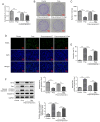Propofol inhibits the malignant development of osteosarcoma U2OS cells via AMPK/FΟΧO1-mediated autophagy
- PMID: 35949604
- PMCID: PMC9353775
- DOI: 10.3892/ol.2022.13430
Propofol inhibits the malignant development of osteosarcoma U2OS cells via AMPK/FΟΧO1-mediated autophagy
Abstract
It has previously been reported that propofol regulates the development of human osteosarcoma (OS). However, the specific molecular mechanisms underlying the effect of propofol on OS remain poorly understood. Therefore, the aim of the present study was to explore the effects of propofol on OS U2OS cells and the potential underlying mechanism. The Cell Counting Kit-8 and colony formation assays were performed to assess cell viability and proliferation. Furthermore, cell apoptosis was assessed using the TUNEL assay and western blotting. Wound healing and Transwell assays were performed to evaluate OS cell migration and invasion abilities, respectively. The protein expression levels of epithelial-mesenchymal transition (EMT)-, autophagy- and adenosine monophosphate-activated protein kinase (AMPK)/FOXO1 signaling pathway-related proteins were also determined using western blotting. The results demonstrated that propofol significantly reduced the viability of OS cells and promoted autophagy in a dose-dependent manner. Moreover, cell treatment with propofol significantly enhanced the protein expression levels of phosphorylated (p)-AMPK and FOXO1, while decreasing the protein levels of p-FOXO1. Furthermore, treatment with propofol significantly suppressed cell viability, migration and invasion abilities and the EMT of OS cells, and potentially promoted cell apoptosis via inducing autophagy via the AMPK/FOXO1 signaling pathway. In summary, the present study indicated that propofol potentially had an inhibitory effect on the development of OS cells via AMPK/FOXO1-mediated autophagy. These results have therefore provided an experimental basis for further studies into the therapeutic effect of propofol on OS.
Keywords: adenosine monophosphate-activated protein kinase/FOXO1 signaling pathway; autophagy; metastasis; osteosarcoma; propofol.
Copyright: © Dai et al.
Conflict of interest statement
The authors declare that they have no competing interests.
Figures




Similar articles
-
Diallyl trisulfide inhibits osteosarcoma 143B cell migration, invasion and EMT by inducing autophagy.Heliyon. 2024 Feb 22;10(5):e26681. doi: 10.1016/j.heliyon.2024.e26681. eCollection 2024 Mar 15. Heliyon. 2024. PMID: 38434350 Free PMC article.
-
Pro-apoptotic and pro-autophagic effects of the Aurora kinase A inhibitor alisertib (MLN8237) on human osteosarcoma U-2 OS and MG-63 cells through the activation of mitochondria-mediated pathway and inhibition of p38 MAPK/PI3K/Akt/mTOR signaling pathway.Drug Des Devel Ther. 2015 Mar 12;9:1555-84. doi: 10.2147/DDDT.S74197. eCollection 2015. Drug Des Devel Ther. 2015. PMID: 25792811 Free PMC article.
-
Histone deacetylase inhibitors promote epithelial-mesenchymal transition in Hepatocellular Carcinoma via AMPK-FOXO1-ULK1 signaling axis-mediated autophagy.Theranostics. 2020 Aug 13;10(22):10245-10261. doi: 10.7150/thno.47045. eCollection 2020. Theranostics. 2020. PMID: 32929346 Free PMC article.
-
Nasopharyngeal carcinoma‑associated gene 6 inhibits cell viability, migration, invasion and induces apoptosis in osteosarcoma cells by inactivating the Wnt/β‑catenin signaling pathway.Mol Med Rep. 2021 Feb;23(2):93. doi: 10.3892/mmr.2020.11732. Epub 2020 Dec 10. Mol Med Rep. 2021. PMID: 33300077
-
Propofol suppresses osteosarcoma cell function by regulating FOXO1/TUSC7.J Pharm Pharmacol. 2021 Apr 27;73(6):720-725. doi: 10.1093/jpp/rgab004. J Pharm Pharmacol. 2021. PMID: 33724400
Cited by
-
CMaf-Inducing Protein Promotes LUAD Proliferation and Metastasis by Activating the MAPK/ERK Pathway.Evid Based Complement Alternat Med. 2022 Sep 14;2022:2501846. doi: 10.1155/2022/2501846. eCollection 2022. Evid Based Complement Alternat Med. 2022. PMID: 36159575 Free PMC article.
-
The potential anti-tumor effect of anesthetics on cancer by regulating autophagy.Front Pharmacol. 2024 Feb 28;15:1293980. doi: 10.3389/fphar.2024.1293980. eCollection 2024. Front Pharmacol. 2024. PMID: 38482052 Free PMC article. Review.
References
LinkOut - more resources
Full Text Sources
Research Materials
Miscellaneous
